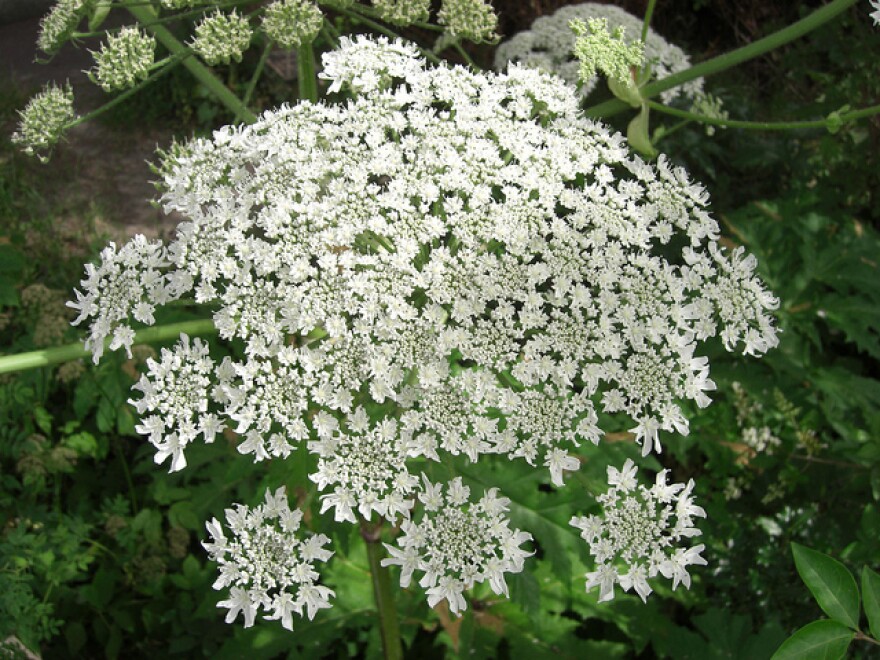An Ovid resident has some giant guests in her yard who've worn out their welcome.
Giant hogweed is a towering plant that can grow as tall as 14 feet, with white flowers spreading up to two feet in diameter. While it’s nice to look at, giant hogweed is a highly toxic plant that can cause severe burns and even blindness.
Botanist Peter Carrington is the man Michigan State University is sending to uproot this invasive species. He’s the assistant curator of the W.J. Beal Botanical Garden at MSU.
WKAR’s Kevin Lavery caught up with Carrington shortly before he was preparing to borrow a hazmat suit to do battle with the beast.
PETER CARRINGTON: This is actually an Asian species, and it grows in Michigan as an unwanted alien invader capable of taking over large tracts of land quite quickly.
KEVIN LAVERY: How widespread is this plant, and have there been attempts to completely eradicate it in Michigan?
CARRINGTON: Oh, yes. I would say there is a constant and ongoing effort to keep this plant eradicated in Michigan. Places like Great Britain have tremendous issues trying to control and eradicate this plant.
LAVERY: Now, for you to remove this plant from this residence in Ovid, you have to take some pretty extraordinary precautions. Explain what is necessary to keep yourself and those around you safe.
CARRINGTON: This group of plants is toxic, and these are sunlight-activated toxins. There are other plants that we’re very familiar with that carry these toxins as well. Probably one of the most recognizable would be the garden parsnip. If you were to find wild parsnip growing as a weed some four to six feet tall, and on a hot day took your shirt off and waded into it with a weed trimmer, the confluence of moisture on your skin, sap and sunlight would cause huge, fluid-filled blisters to erupt on the skin. Giant hogweed also carries these same chemicals. This plant is actually fuzzy and actually wears a small droplet of these components right out on the outside of the plant. So you can be burned literally by just simply shoving your way through this plant. While this is a cosmetic disaster on your skin, if these products ever make it to your eyeballs, they can cause temporary, or in the worst case scenario, permanent blindness.
LAVERY: Now, I hope that the owner of this plant has not been harmed or anyone else has been harmed, and that’s obviously the reason why you’re going to remove this plant there.
CARRINGTON: Yes; that would be the good news. This person actually identified the plant and researched it a bit on her own, and she became quite anxious to rid her property of this stuff. She actually acquired these plants from a family member who had grown this plant and thought it was a gigantic sort of semi-tropical accent plant.
LAVERY: What’s your battle plan when you introduce yourself to said invader?
CARRINGTON: Well, my personal interest in this plant as a toxic plant instructor is to get good pictures that I can represent this plant both in publications and to my students. My strategy once I get there and get my pictures is to cover myself in a chemically protected suit and to disassemble this plant and put it into sealed containers for disposal. Now, we have some interest in this plant at the (MSU) herbarium, and so we will be taking it to the herbarium to look at and to take some images and maybe save some samples for some further research. But after that, it will be disposed of as though it were a toxic product of its own.
LAVERY: Have you ever done this kind of thing before? Have you ever encountered this sort of force – if that’s the word for it – in your career?
CARRINGTON: Well, you know, as toxic plants go, this is certainly a unique and gigantic specimen to work with. And so it’s certainly a little more challenging in this way than anything I’ve ever touched before.
LAVERY: How is this a cautionary tale for other people who may think they have a similar plant on their property?
CARRINGTON: That’s a good question. Invasive and dangerous plants generally fly under the radar for most of us civilians. But if you think you have one or there’s one growing around you, the Michigan Invasive Plant Council in Lansing has phone numbers and they will help bring the resources you need to your door if necessary to get this out of the way.


